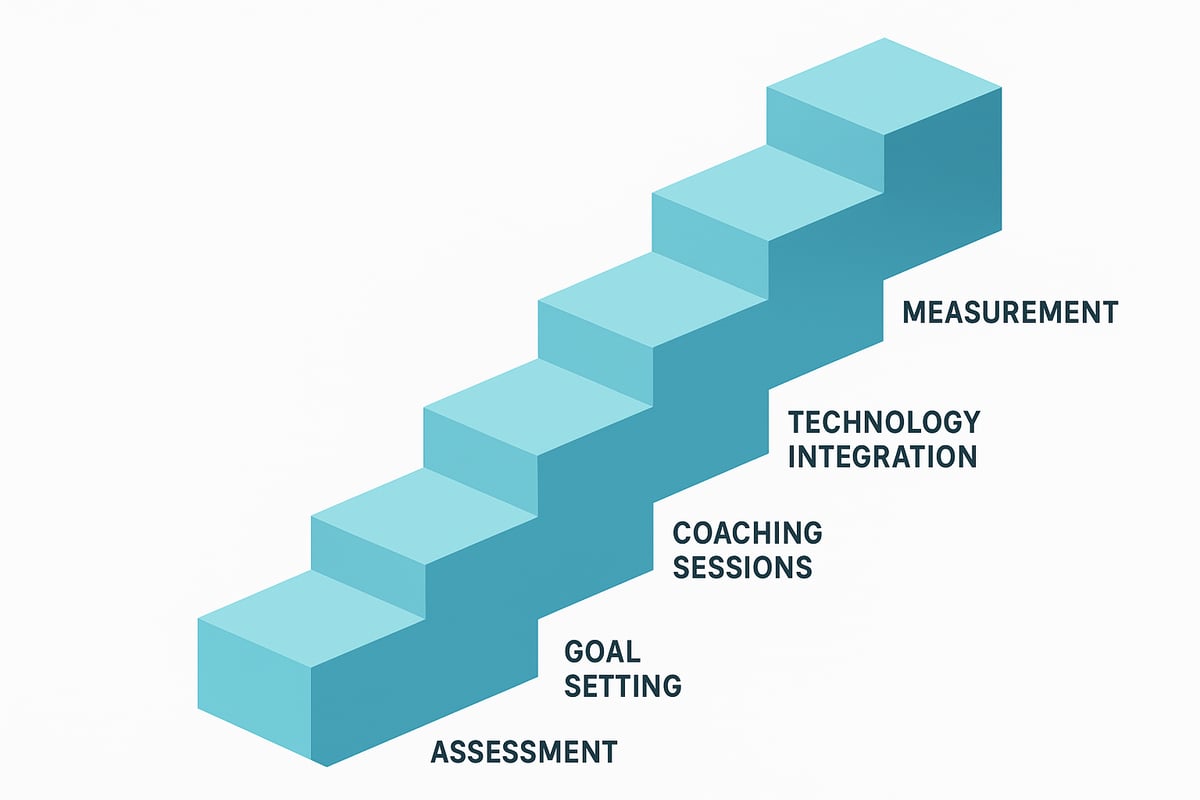Guide to Leadership Development and Coaching Success 2025
In a rapidly changing business landscape, the leaders who thrive are those who never stop developing. As organizations face new challenges in 2025, the need for leadership development and coaching has never been more urgent.
This guide unpacks the latest strategies, frameworks, and practical steps to empower both individuals and teams. Did you know that 97% of coached leaders report improved effectiveness? Here, you’ll discover actionable insights, expert-backed models, and inspiring success stories.
Ready to unlock your full leadership potential? Dive in as we explore trends, core competencies, proven coaching models, implementation, technology integration, measurement, and best practices.
The State of Leadership Development in 2025
In 2025, leadership development and coaching are at the heart of organizational success. Companies are navigating a business landscape shaped by rapid change, hybrid work, and global collaboration. As organizations evolve, the demand for agile leaders who can manage uncertainty and drive results has never been greater.

Key Trends and Emerging Challenges
The post-pandemic era has redefined leadership development and coaching. Hybrid work is now the norm, and organizations are building teams that span continents and time zones. Leaders must adapt to new ways of working while ensuring productivity and engagement.
Change management, talent retention, and navigating uncertainty top the list of challenges for leaders, as highlighted by CCL’s “Top 20 Leadership Challenges.” Traditional training approaches are no longer sufficient. Instead, organizations are shifting to more personalized, scalable coaching solutions that support leaders at every level.
Diversity, equity, and inclusion have become central to leadership pipelines. Companies are investing in coaching programs that foster diverse perspectives and inclusive cultures. In fact, 97% of leaders who receive coaching report greater effectiveness, a testament to the impact of these efforts.
Fortune 1000 companies are leading the way by rolling out large-scale coaching initiatives. The trend toward digital and personalized coaching is accelerating, with investments projected to grow significantly. For a deeper dive into these trends, explore the Top Leadership Coaching Trends.
Essential Leadership Competencies for 2025
To succeed in this environment, organizations are redefining the core competencies required for leadership development and coaching. Emotional intelligence and self-awareness are now foundational. Leaders who understand their own strengths and limitations can better connect with their teams.
Strategic thinking and decision-making skills are critical in complex, fast-paced settings. Effective communication and active listening help leaders bridge the gap between remote and in-person teams. Building resilience and adaptability enables leaders to thrive during periods of disruption.
Cultivating a growth mindset and openness to feedback drives continuous improvement. Leaders who align personal and organizational goals consistently deliver better business results. The data speaks for itself: 94% of those who receive leadership development and coaching report improved job performance.
Here’s a summary of the most essential competencies:
| Competency | Why It Matters in 2025 |
|---|---|
| Emotional Intelligence | Drives team engagement |
| Strategic Thinking | Navigates complex challenges |
| Communication | Unites hybrid teams |
| Resilience | Sustains performance in change |
| Growth Mindset | Fuels innovation and learning |
Organizations that focus on these skills are building stronger leadership pipelines and unlocking higher performance.
Core Principles of Effective Leadership Coaching
Unlocking the true value of leadership development and coaching starts with core principles that drive meaningful, measurable results. In today’s complex business world, organizations need more than generic training—they require a strategic approach that transforms leaders at every level.

What Makes Leadership Coaching Successful?
Effective leadership development and coaching always begins with a personalized, outcomes-focused approach. Each leader faces unique challenges and goals, so programs must be tailored to individual and organizational needs. Integrating coaching into broader talent development strategies ensures alignment with business objectives and lasting cultural impact.
A successful coaching journey uses validated assessment tools and 360-degree feedback to establish clear baselines and track real progress. Structured development plans, ongoing progress tracking, and open communication create an environment where leaders can thrive. Trust and honest feedback are essential, as they foster self-awareness and drive continuous growth.
Consider the example of executive coaching for leaders transitioning into new roles. With a custom plan, targeted feedback, and regular check-ins, these leaders quickly adapt and deliver greater impact. Data shows that 97% of coached leaders contribute more to organizational success, highlighting the importance of a robust leadership development and coaching framework.
To explore proven models and resources for building these programs, visit Leadership Coaching Strategies, where you’ll find in-depth guidance for every stage of the coaching process.
| Success Factor | Description |
|---|---|
| Personalization | Tailors coaching to the leader’s context and goals |
| Outcomes Focus | Sets clear, measurable objectives and tracks progress |
| Integration | Aligns coaching with overall talent and business strategy |
| Assessment and Feedback | Uses data-driven tools for insight and accountability |
| Trust-Based Communication | Builds a foundation for honest dialogue and growth |
The Role of the Coach: Trusted Partner and Catalyst
At the heart of leadership development and coaching is the coach—a trusted partner and catalyst for change. Coaches serve as thought partners and sounding boards, helping leaders challenge assumptions and discover hidden blind spots. Their expertise facilitates self-awareness and transformative growth, which is essential in today’s rapidly evolving business landscape.
A skilled coach supports leaders as they navigate real-world challenges, from managing change to building resilient teams. Team coaching, for example, can dramatically improve collaboration and resolve interpersonal dynamics that hinder performance. The right coach brings deep sector expertise and aligns with the organization’s culture, ensuring that coaching interventions are both relevant and impactful.
Coach selection is critical. A coach must understand both the industry context and the unique needs of each leader. When this alignment is achieved, leadership development and coaching become powerful levers for organizational performance and cultural health.
Step-by-Step Guide to Building a Leadership Development and Coaching Program
Building a successful leadership development and coaching program requires a structured, evidence-based approach. By following these five steps, organizations can create impactful programs that drive measurable results, boost leader effectiveness, and support long-term business growth.

Step 1: Assess Organizational and Leadership Needs
Start by diagnosing the current state of leadership within your organization. Use evidence-based tools like 360-degree assessments, surveys, and interviews to capture strengths, development gaps, and behavioral patterns.
Tailor your assessment process to fit your organization’s context. For example, a government agency may need compliance-focused diagnostics, while a Fortune 500 firm might prioritize innovation and agility.
Align findings with organizational goals and regulatory requirements. This ensures your leadership development and coaching efforts are targeted and relevant from the outset.
Step 2: Define Clear Objectives and Success Metrics
Next, set measurable objectives and KPIs for your leadership development and coaching program. These could include leader engagement, retention rates, or specific business outcomes like revenue growth or improved culture scores.
Ensure objectives align with both organizational strategy and culture. Establish clear accountability structures and reporting lines so progress is visible and leaders remain committed.
For example, companies often track leadership ROI through defined metrics, such as improvements in team performance or reduction in turnover.
Step 3: Design a Tailored Coaching and Development Plan
Match leaders with coaches who bring the right sector expertise and interpersonal style. Design individualized learning paths that blend executive, team, and integrated coaching components for maximum impact.
Custom intervention plans are essential for addressing unique leadership challenges. If toxic behaviors or low engagement are present, leverage resources like Transforming Toxic Leadership to guide effective change.
Incorporate regular feedback loops and progress check-ins. This ensures your leadership development and coaching plan stays agile and responsive to evolving needs.
Step 4: Implement and Scale Coaching Initiatives
Pilot your leadership development and coaching program with a select group before scaling organization-wide. Use technology to support virtual or hybrid coaching delivery, making programs accessible to distributed teams.
Train managers to champion a coaching culture and facilitate peer learning networks. This multiplies the program’s impact and fosters sustainable leadership growth.
Large organizations often blend boutique-level customization with enterprise-scale delivery, ensuring leaders at every level receive relevant support.
Step 5: Monitor, Measure, and Refine
Continuous measurement is vital for leadership development and coaching success. Gather feedback from participants and stakeholders using surveys, interviews, and qualitative insights.
Leverage data analytics to track improvements in performance, culture, and business outcomes. Adjust your program based on these results and any shifting organizational needs.
Many organizations report significant gains in leader effectiveness after coaching.
Integrating Technology and Innovation in Leadership Coaching
The landscape of leadership development and coaching is transforming at an unprecedented pace. Technology is now at the core of how organizations equip leaders for success in a digital-first world. With innovation accelerating, the tools and platforms available in 2025 are more advanced, accessible, and impactful than ever before.

Digital Tools and Platforms Shaping Coaching in 2025
AI-powered solutions are revolutionizing leadership development and coaching. Smart matching algorithms now pair leaders with coaches who fit their unique needs, industry, and goals. These platforms analyze behavioral data, preferences, and leadership challenges to ensure a precision fit.
Virtual coaching platforms have made it possible for global teams to receive consistent development, regardless of location or time zone. Mobile apps now deliver self-paced leadership development and coaching content, enabling learning on demand. Data-driven dashboards track progress, highlight growth areas, and measure ROI in real time.
For example, proprietary technology can match leaders to coaches with specialized sector experience, making each engagement more relevant and effective. This shift to personalized, scalable solutions not only increases access but also ensures that every leader receives targeted support. According to recent research, the integration of AI and analytics is elevating the impact and efficiency of executive coaching AI integration in executive coaching.
These innovations are making leadership development and coaching more measurable, transparent, and adaptable than ever before.
The Future of Hybrid and Remote Leadership Coaching
As hybrid and remote work become the norm, leadership development and coaching must adapt to new modes of engagement. The best programs leverage virtual platforms to facilitate interactive, high-impact sessions that build trust, even across screens.
A key challenge is maintaining authentic connection in digital spaces. Coaches now use video, chat, and collaborative tools to foster open communication and deepen relationships. Integrating asynchronous learning—such as micro-courses and digital reflections—with live coaching sessions helps leaders apply lessons in real time while accommodating diverse schedules.
Organizations with distributed teams are already seeing the benefits. Success stories highlight improved collaboration, higher engagement, and stronger leadership pipelines, regardless of geography. By embracing technology, companies ensure that leadership development and coaching remain accessible, scalable, and effective into the future.
Creating a Coaching Culture for Sustained Leadership Success
Building a true coaching culture transforms leadership development and coaching from a periodic activity into a daily practice. Organizations that embed coaching into their DNA equip every leader and employee to grow continuously, adapt quickly, and unlock their full potential. In 2025, the organizations that thrive will be those that make leadership development and coaching part of every conversation, not just a one-time event.
Moving from Episodic Training to Ongoing Coaching Conversations
Traditional leadership development and coaching programs often stop at workshops or annual reviews. However, this static approach falls short in today’s fast-changing workplace. A coaching culture replaces one-off interventions with continuous, real-time feedback and growth opportunities.
Daily coaching conversations empower leaders to address challenges as they arise, while peer coaching networks encourage knowledge sharing across teams. By making coaching a regular part of work, organizations foster agility and engagement at every level.
Training Managers to Coach and Foster Peer Networks
Managers play a pivotal role in sustaining leadership development and coaching. When managers are trained as coaches, they become catalysts for performance and morale. These leaders model effective coaching behaviors, ask powerful questions, and nurture their teams’ strengths.
Peer coaching networks also amplify impact. Employees learn to support each other, building trust and accountability. Organizations that leverage both professional coaches and peer support see stronger leadership pipelines and a more resilient workforce.
Aligning Coaching Initiatives with Values and Frameworks
For leadership development and coaching to stick, it must align with your company’s values and leadership frameworks. Coaching should reinforce what matters most, from collaboration and innovation to ethical decision-making.
Integrating coaching into existing processes—such as performance reviews, onboarding, or talent development—ensures consistency and relevance. Encouraging ongoing reflection and feedback keeps leaders focused on growth, not just compliance.
Encouraging Continuous Feedback, Reflection, and Growth
Sustained leadership development and coaching thrive on a culture of open feedback. Leaders must feel safe to seek input, reflect on their actions, and experiment with new approaches. Regular check-ins, mentorship, and transparent communication drive continuous improvement.
A coaching culture normalizes vulnerability and learning, making it easier to adapt to change and overcome setbacks. Teams that embrace this mindset outperform their peers in engagement, retention, and innovation.
Real-World Impact: Outperforming Peers Through Coaching Culture
Organizations that make leadership development and coaching routine consistently outperform those that rely on sporadic training. They report higher engagement, better retention, and stronger business results.
Measuring the Impact and ROI of Leadership Development and Coaching
Metrics That Matter for 2025
Measuring the impact of leadership development and coaching is essential for demonstrating value and driving ongoing investment. In 2025, organizations are moving beyond basic participation metrics to focus on outcomes that reflect true leadership growth and business impact.
Core KPIs now include leader effectiveness, employee engagement, retention rates, and direct business performance. These indicators are tracked using both quantitative and qualitative methods, creating a holistic view of progress.
| KPI | Measurement Method |
|---|---|
| Leader Effectiveness | 360-degree feedback, pre- and post-surveys |
| Employee Engagement | Annual engagement surveys, pulse checks |
| Retention | Turnover statistics, exit interviews |
| Business Performance | Revenue growth, productivity metrics |
| Cultural Health | Qualitative feedback, team climate surveys |
Organizations increasingly use pre- and post-assessment data to quantify the impact of leadership development and coaching. By comparing results over time, companies can pinpoint areas of growth and identify where further investment is needed.
The shift toward virtual coaching and personalized learning paths, highlighted in leadership development program market trends, has also streamlined the measurement process. Digital dashboards now enable real-time tracking of progress, making it easier to tie coaching investments directly to business outcomes.
Case Studies and Success Stories
Real-world examples reinforce the value of measuring leadership development and coaching. One global technology firm launched a large-scale coaching initiative and reported a 97% increase in leader contribution to organizational success, backed by robust pre- and post-program assessments.
Another Fortune 500 company focused on building a resilient leadership pipeline. After implementing a targeted coaching program, HR data revealed a 94% improvement in job performance among participating leaders and a significant drop in voluntary turnover.
Lessons from these organizations highlight several best practices:
- Integrate qualitative feedback from teams and stakeholders to measure cultural shifts.
- Use data analytics to demonstrate ROI and secure continued budget support.
- Align measurement with both organizational strategy and leadership objectives.
For those looking to deepen their approach, resources like Accountability Now provide further guidance on connecting coaching outcomes with measurable business results.




Leave a Reply
Want to join the discussion?Feel free to contribute!